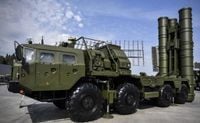On the night of May 7, 2025, tensions between India and Pakistan escalated dramatically as Pakistan launched a coordinated drone and missile attack targeting military installations across northern and western India. This aggressive move came just a day after India executed precision strikes against terrorist camps in Pakistan and Pakistan-occupied Kashmir, a response to a deadly attack that killed 26 tourists in Indian-administered Kashmir.
The Indian Air Force's deployment of the Russian-made S-400 Triumf air defense system was pivotal in countering the threats. This marked the first combat use of the S-400 in Indian hands, underscoring India's growing military capabilities in a region fraught with conflict. According to Indian defense sources, the S-400 successfully intercepted and neutralized the incoming threats, preventing significant damage to critical infrastructure.
The S-400 Triumf, known to NATO as the SA-21 Growler, is a state-of-the-art mobile surface-to-air missile system developed by Russia’s Almaz-Antey corporation. It boasts the ability to engage targets at ranges up to 400 kilometers and altitudes of 30 kilometers, making it a formidable asset against various aerial threats. The system's phased-array radar can track up to 300 targets simultaneously, enhancing its effectiveness in complex combat scenarios.
India's acquisition of the S-400 began in 2015, driven by escalating threats from both Pakistan and China. The urgency for a robust air defense system intensified following China’s deployment of S-400 systems along the Line of Actual Control. In October 2018, India signed a $5.43 billion contract for five S-400 squadrons, despite warnings from the United States about potential sanctions under the Countering America’s Adversaries Through Sanctions Act (CAATSA). The first squadron arrived in December 2021, with deployments aimed at countering threats from Pakistan and deterring China.
On the night of the attack, air raid sirens blared in Jammu as the Indian Air Force engaged the incoming drones and missiles. Eyewitness accounts described streaks of light across the sky, indicating successful interceptions. The situation in Jammu was tense, with a total blackout imposed in the city and surrounding areas as the Indian forces responded to the aerial assault.
Colonel Sofiya Qureshi of India's Ministry of External Affairs confirmed that the Integrated Counter-UAS Grid and Air Defence systems effectively neutralized the threats. She stated, "This morning, the Indian Armed Forces targeted Air Defence Radars and systems at a number of locations in Pakistan. The Indian response has been in the same domain with the same intensity as Pakistan." This retaliatory action was part of a broader strategy to maintain India’s defensive posture amidst ongoing provocations.
The S-400's combat debut was a significant milestone for India. In a July 2024 exercise, the system, which has been renamed Sudarshan by the Indian Air Force, achieved an 80% success rate against simulated enemy aircraft. The successful interception of 15 missiles during the recent attacks further validated India’s investment in this advanced air defense system.
Historically, the relationship between India and Pakistan has been marked by conflict, particularly over the disputed region of Kashmir. Since their partition in 1947, the two nuclear-armed nations have fought three wars and engaged in numerous skirmishes. The 2019 Balakot airstrike, where Indian jets targeted a militant camp in Pakistan, exposed vulnerabilities in both nations' air defenses and prompted India to enhance its military capabilities, including the acquisition of the S-400.
In the wake of the recent attacks, the Indian Air Force’s use of the S-400 has sparked debates about the economic efficiency of employing such expensive interceptors against lower-cost drone threats. Each interceptor is estimated to cost between $1 to $2 million, raising questions about the sustainability of such a defense strategy. However, the S-400's ability to engage a wide range of threats, including ballistic missiles and stealth aircraft, positions it as a crucial component of India’s defense strategy.
The broader implications of the S-400’s combat debut extend beyond immediate military engagements. For India, it validates a multi-layered defense strategy that combines Russian, indigenous, and Western systems. The Indian Air Force operates French Rafale jets, Israeli Heron drones, and U.S.-supplied Predator drones, reflecting a diversification away from its historical reliance on Russian military hardware.
For Russia, the successful operation of the S-400 in India serves as a powerful marketing tool in the global arms market, demonstrating the system's reliability to potential buyers. Meanwhile, the engagement has altered the strategic calculus in South Asia, widening the technological gap between India and Pakistan. Pakistan’s reliance on Chinese systems, including the HQ-9, underscores its challenges in matching India’s advanced capabilities.
As the situation continues to evolve, the human element behind the S-400’s success cannot be overlooked. Indian operators, trained extensively in both Russia and India, executed their mission under real-time pressure, showcasing the importance of skilled personnel in modern warfare. This operation has also bolstered public confidence in Prime Minister Narendra Modi’s government, which has faced increasing pressure to respond decisively to Pakistan’s provocations.
Looking ahead, India’s reliance on the S-400 will shape its defense strategy. The system’s versatility ensures its relevance against diverse threats, but high operational costs demand a balanced approach. Integrating cheaper systems like Akash or exploring emerging technologies could enhance operational efficiency. The delays in Russia’s deliveries, compounded by its focus on Ukraine, may prompt India to seek alternative suppliers, a trend already evident in its recent deals for U.S. drones and French jets.
In conclusion, the S-400 stands as a symbol of India’s military evolution, capable of altering the dynamics of South Asian security. Yet, as asymmetric warfare tactics proliferate, the question remains: can India sustain the financial and strategic costs of wielding such advanced technology in an era of rapidly evolving warfare?






